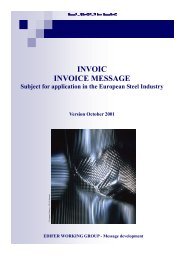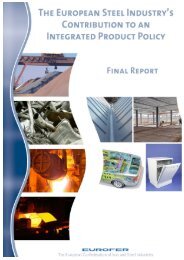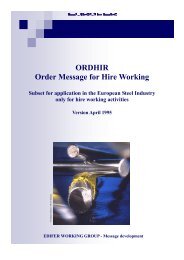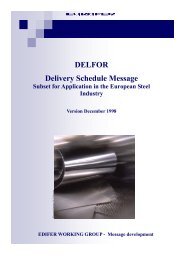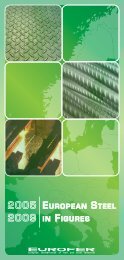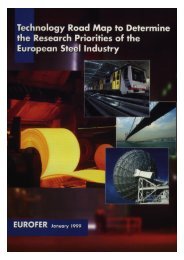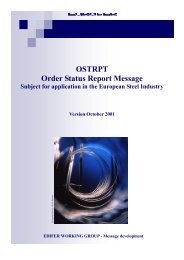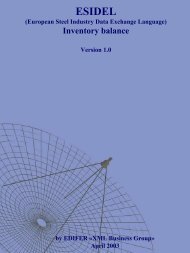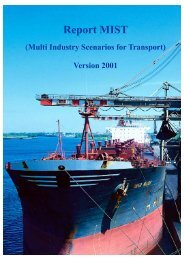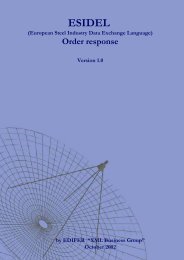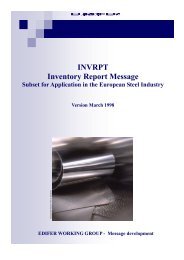manufacture, processing and use of stainless steel - International ...
manufacture, processing and use of stainless steel - International ...
manufacture, processing and use of stainless steel - International ...
You also want an ePaper? Increase the reach of your titles
YUMPU automatically turns print PDFs into web optimized ePapers that Google loves.
Grinding <strong>of</strong> <strong>stainless</strong> <strong>steel</strong><br />
Airborne dust from grinding <strong>of</strong> <strong>stainless</strong> <strong>steel</strong> is made up <strong>of</strong> spinels <strong>and</strong> therefore has<br />
a different chemical composition <strong>and</strong> metallurgical structure to that <strong>of</strong> metallic<br />
<strong>stainless</strong> <strong>steel</strong>. A proportion <strong>of</strong> the airborne dust particles are respirable <strong>and</strong> therefore<br />
grinding operations present the potential for inhalation exposure in the occupational<br />
setting. Grinding activities frequently accompany welding operations <strong>and</strong> also occur<br />
during the later stages <strong>of</strong> <strong>stainless</strong> <strong>steel</strong> <strong>manufacture</strong>.<br />
Data on the acute toxicity <strong>of</strong> grinding dust from <strong>stainless</strong> <strong>steel</strong> are limited to a single<br />
animal intratracheal (i.t.) instillation study which simply showed that a suspension <strong>of</strong><br />
grinding dust (up to 112 mg/kg) was non-lethal in hamsters.<br />
Animal data on the effects <strong>of</strong> repeated exposure are limited to a single study. Effects<br />
on body weight occurred with repeated i.t. instillation <strong>of</strong> up to 9 mg dust (total <strong>of</strong> 12<br />
doses administered at 14-day intervals); information regarding other effects was not<br />
available <strong>and</strong> it was not possible to identify a NOAEL. No human data are available<br />
concerning the effects <strong>of</strong> repeated exposure to grinding dust.<br />
Data from two i.t.-dosing carcinogenicity bioassays provide no evidence for the<br />
carcinogenicity <strong>of</strong> grinding dust from <strong>stainless</strong> <strong>steel</strong>, with two austenitic grades <strong>and</strong><br />
one ferritic grade failing to induce lung tumours.<br />
Two available studies <strong>of</strong> cancer risks in grinders <strong>of</strong> <strong>stainless</strong> <strong>steel</strong> do not indicate that<br />
such work leads to excess risks <strong>of</strong> lung cancer. One study reported cancer findings<br />
under broad headings rather than for individual cancer sites. Nevertheless, it provided<br />
no support for the hypothesis <strong>of</strong> an effect on cancers <strong>of</strong> the colon <strong>and</strong> rectum<br />
suggested by the other study.<br />
When data concerning the hazards <strong>of</strong> grinding dust from <strong>stainless</strong> <strong>steel</strong> are evaluated<br />
against the current EU classification criteria, no concern would appear to be raised in<br />
relation to any <strong>of</strong> the toxicological end-points.<br />
According to the available data, there appears to be no identifiable hazard associated<br />
specifically with grinding dust from <strong>stainless</strong> <strong>steel</strong>. Nevertheless, as some <strong>of</strong> the<br />
airborne dust is respirable <strong>and</strong> thus presents the potential for inhalation exposure, it<br />
appears appropriate to treat grinding dust as any other kind <strong>of</strong> dust <strong>and</strong> to control<br />
exposure to the appropriate exposure limit 3 .<br />
Although there are gaps in the toxicological database for grinding dust, there appear<br />
to be no major concerns for health <strong>and</strong> therefore no further testing is warranted.<br />
Cutting <strong>of</strong> <strong>stainless</strong> <strong>steel</strong><br />
Cutting <strong>of</strong> <strong>stainless</strong> <strong>steel</strong> may be performed using mechanical, laser or plasma cutting<br />
methods. Plasma cutting performed in the open atmosphere appears to be the only<br />
method which presents the potential for inhalation exposure in the workplace.<br />
3 3 3<br />
In the UK, the occupational exposure limit for dust is 10 mg/m (total inhalable dust) or 4 mg/m<br />
(respirable dust).<br />
vii



